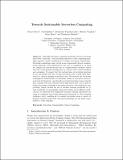Toward sustainable serverless computing
Abstract
Although serverless computing generally involves executing short-lived “functions,” the increasing migration to this computing paradigm requires careful consideration of energy and power requirements. serverless computing is also viewed as an economically-driven computational approach, often influenced by the cost of computation, as users are charged for per-subsecond use of computational resources rather than the coarse-grained charging that is common with virtual machines and containers. To ensure that the startup times of serverless functions do not discourage their use, resource providers need to keep these functions hot, often by passing in synthetic data. We describe the real power consumption characteristics of serverless, based on execution traces reported in the literature, and describe potential strategies (some adopted from existing VM and container-based approaches) that can be used to reduce the energy overheads of serverless execution. Our analysis is, purposefully, biased toward the use of machine learning workloads because: (1) workloads are increasingly being used widely across different applications; (2) functions that implement machine learning algorithms can range in complexity from long-running (deep learning) versus short-running (inference only), enabling us to consider serverless across a variety of possible execution behaviors. The general findings are easily translatable to other domains.
Citation
Patros , P , Spillner , J , Papadopoulos , A , Varghese , B , Rana , O & Dustdar , S 2021 , ' Toward sustainable serverless computing ' , IEEE Internet Computing , vol. 25 , no. 6 , pp. 42-50 . https://doi.org/10.1109/MIC.2021.3093105
Publication
IEEE Internet Computing
Status
Peer reviewed
ISSN
1089-7801Type
Journal article
Collections
Items in the St Andrews Research Repository are protected by copyright, with all rights reserved, unless otherwise indicated.
Related items
Showing items related by title, author, creator and subject.
-
Virtual Worlds and the 3D Web – time for convergence?
Bakri, Hussein; Allison, Colin; Miller, Alan Henry David; Oliver, Iain Angus (Springer, 2016) - Conference itemMulti-User Virtual Worlds (MUVW) such as Open Wonderland and OpenSim have proved to be fruitful platforms for innovative educational practice, supporting exploratory learning and generating true engagement. However, when ... -
Studying programmer behaviour at scale : a case study using Amazon Mechanical Turk
Jacques, Jason T.; Kristensson, Per Ola (ACM, 2021-03-22) - Conference itemDeveloping and maintaining a correct and consistent model of how code will be executed is an ongoing challenge for software developers. However, validating the tools and techniques we develop to aid programmers can be a ... -
Investigating the accessibility of crowdwork tasks on Mechanical Turk
Uzor, Stephen; Jacques, Jason T.; Dudley, John J.; Kristensson, Per Ola (ACM, 2021-05-06) - Conference itemCrowdwork can enable invaluable opportunities for people with disabilities, not least the work fexibility and the ability to work from home, especially during the current Covid-19 pandemic. This paper investigates how ...

